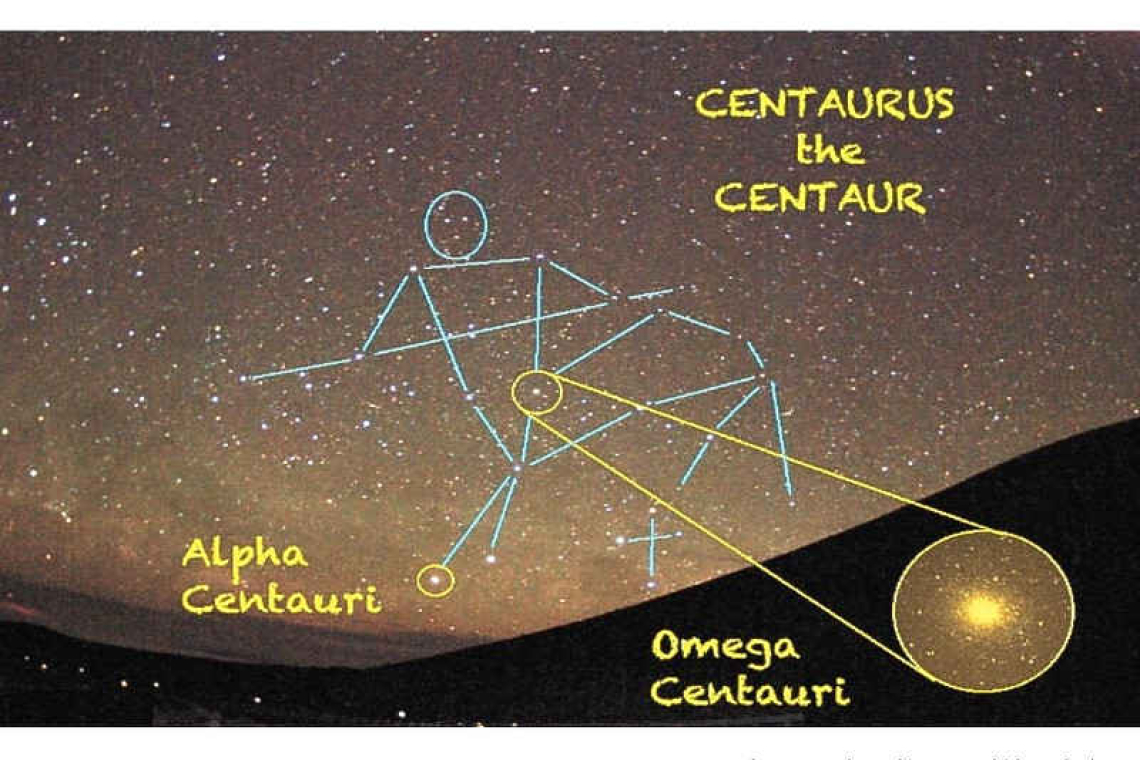~ St. Maarten’s Backyard Astronomy for March 31 – April 2 ~
Sun rises at 6:06am
Sun sets at 6:25pm
Lunar phase: 2nd Quarter, Waxing Gibbous
Moon rises at 3:05pm,
Moon sets at 3:24am
Welcome to April! This weekend, we are going deep and that’s no joke! We search the southern skies for a faint star, which isn’t really a star at all; so maybe it is a joke? Anyway, we hope to find something known as a globular cluster. Don’t get too excited, ladies, it’s only a spherical cluster of stars, crowded together in a rather small region of the sky. We seek Omega Centauri in the constellation Centaurus. You may have learned at one time that our closest star, other than our sun, is Alpha Centauri. Yes – that too is located in the constellation Centaurus.
The constellation Centaurus is, of course, a centaur, the mythological beast with the body of a horse and the torso, head, and arms of a man. You’ll find the Centaur very low on the southern horizon, his horse’s belly arcs over the Southern Cross or Crux, which is much better known to star gazers (see image provided).
It might be helpful to locate two other constellations and “star-hop” to Omega Centauri. The first is Leo the Lion. He will be high in the sky towards the southwest. Leo is recognized by a “backwards question mark shape” which represents the lion’s mane. Saturday night, the moon will sit at Leo’s throat, so you can’t miss him. Now, star-hop left, or eastward, towards Virgo the Maiden – she is lying on her side and her head is right next to the lion’s tail. Virgo’s brightest star is Spica. From Spica, star-hop down towards the Southern Cross – the region you want is a little more than halfway from Spica to Crux. It is visible with the naked eye, but will be more impressive with any magnification, such as binoculars.
Omega Centauri contains some of our Milky Way galaxy’s most ancient stars. Many northern stargazers have Omega Centauri as well as Crux on their bucket list because they are too far south to be seen from many northern locations.
An ideal time for searching for Omega Centauri this weekend is 11:00pm Saturday to 1:00am Sunday morning. Having said that, if the weather doesn’t cooperate; you could seek it out another night as the week progresses. Most important is to have clear skies and no lights around you. Since stars appear in the sky about four minutes earlier with each night, Spica and Omega Centauri will be up highest for the night around one hour earlier in mid-April, and two hours earlier by the end of April.
Thank you for keeping up with the Night Sky articles, backyard astronomy designed for St. Maarten sky viewing. FYI: If you are out later on in the week, note that each star rises about four minutes earlier each day than written here, and the moon rises 50 minutes later. Night Sky is researched and compiled by Lisa Davis-Burnett. Earthsky.org is a key resource for information and images. Special thanks this week to Jimmy Westlake who provided the image of the constellation Centaurus. Questions or comments? Email This email address is being protected from spambots. You need JavaScript enabled to view it.







